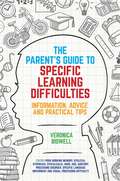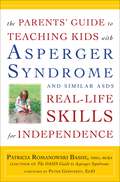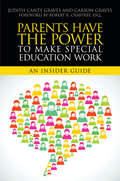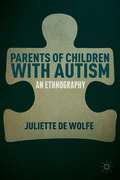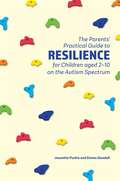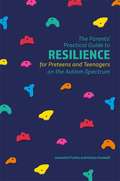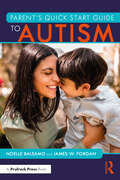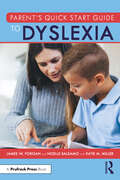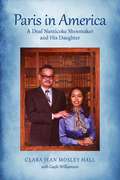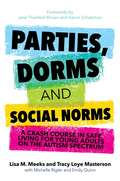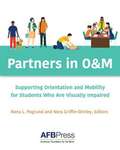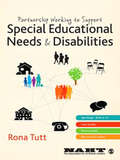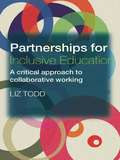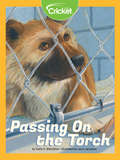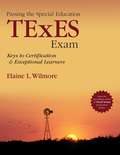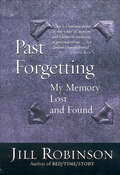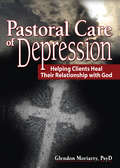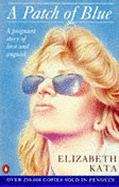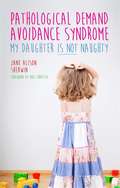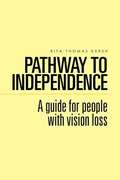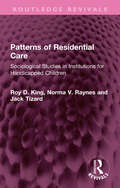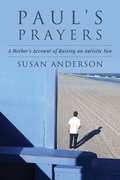- Table View
- List View
The Parents' Guide to Specific Learning Difficulties: Information, Advice and Practical Tips
by Veronica BidwellPacked full of advice and practical strategies for parents and educators, this book is a one-stop-shop for supporting children with Specific Learning Difficulties (SpLDs). Part one introduces a spectrum of SpLDs, ranging from poor working memory, dyslexia, dyspraxia, dyscalculia, through to ADHD, Autism Spectrum Disorder (ASD), Auditory Processing Disorder (APD), Specific Language Impairment and Visual Processing Difficulty. It explains clearly what each difficulty is, how it can affect a child's learning and how to help a child to succeed despite their difficulties. Part two includes a host of tips, tools and strategies to support your child's efforts in areas such as reading, writing, spelling and handwriting, as well as advice on motivation, confidence and managing life's setbacks. Written by an experienced Educational Psychologist, this is the perfect guide for parents and carers who are looking for ways to support their child's learning, as well as for educators and teachers looking for advice on how to differentiate lessons and motivate pupils with SpLDs.
The Parents' Guide to Teaching Kids with Asperger Syndrome and Similar ASDs Real-Life Skills for Independence
by Patricia Romanowski Peter GerhardtThe definitive resource for teaching kids with Asperger syndrome the life skills that build independence, confidence, and self-esteem. Children with autism spectrum disorders learn differently. Our kids' choices are too often limited and their paths to success restricted, not by a lack of intellectual ability but by deficits in acquiring, applying, and generalizing basic life skills. Success in school, at home, on the playground, and beyond depends on mastering countless basic living skills that most other kids just "pick up" almost by osmosis. This book shows parents how to teach these so-called easy skills to complex learners. This is the first book for parents and caregivers of kids with Asperger syndrome and similar learning profiles that features strategies based on applied behavior analysis--the most widely accepted, evidence-based, and effective teaching method for learners with ASDs--including how to: -Identify critical skills appropriate for your child's age--how to teach them and why-Implement new techniques that can replace, mimic, prompt, override, or impose missing order on your child's learning style -Design a curriculum for your child that reduces reliance on prompts (including parents) and promotes new learning, new behaviors, and independenceFrom the Trade Paperback edition.
Parents Have the Power to Make Special Education Work: An Insider Guide
by Judith Canty Graves Carson GravesWritten by parents who have been through the US special education system, this book cuts through the jargon to provide other parents with a no-nonsense road map full of valuable first-hand insights and tried-and-tested advice. The authors clearly describe: · the special education process, including the school hierarchies parents are likely to encounter and etiquette to be aware of when dealing with school personnel · the information parents should expect to see in school evaluations and Individualized Education Programs (IEPs), and what to do when this information is missing or insufficient · problems parents may encounter when the needs of the school conflict with the needs of a child, including how to deal with such situations and when to seek legal advice · the importance of organizing special education documentation and establishing a 'paper trail', and how to begin this process · why transition planning is so important, and transition services parents may want to consider for their child. Demonstrating that parents really do have the power to make special education work for their child, this empowering guide is essential reading for parents of children with disabilities who are new to the special education system in the US, as well as those who feel frustrated with the system.
Parents of Children with Autism
by Juliette De WolfeIn a readable and highly accessible ethnographic account that is shaped by the stories of families and the voices of parents, De Wolfe examines how parents of children with autism navigate the educational and medical systems, understand their own and their children's bodies, and support and educate one another.
The Parents' Practical Guide to Resilience for Children aged 2-10 on the Autism Spectrum: Two to Ten Years
by Jeanette Purkis Emma GoodallChildren and young people with autism have the capacity to be independent and resilient which can help them live independently or be supported to live a fulfilling life and reach their full potential. This book empowers parents of autistic children aged two to ten to help them promote resilience in their child. Full of suggestions and simple activities, this easy-to-use resource will help guide parents on how to build the foundations of resilience and independence for situations such as school, new environments and relationships with other children. It includes information about the main developmental stages for children on the autism spectrum, and will take parents through life events and milestones at different ages and identify where difficulties and barriers to resilience may arise and how to address them.
The Parents’ Practical Guide to Resilience for Preteens and Teenagers on the Autism Spectrum
by Jeanette Purkis Emma GoodallThis book empowers parents of autistic young people aged 11 to 20 to help them promote resilience in their child. Full of suggestions and simple activities, this easy-to-use resource will help guide parents on how to build the foundations of resilience and independence for situations such as negotiating sexuality and relationships, entering employment or living away from home. It includes information about the main developmental stages for preteens and teens on the autism spectrum, and will take parents through life events and milestones at different ages and identify where difficulties and barriers to resilience may arise and how to address them.
Parent's Quick Start Guide to Autism
by Noelle Balsamo James W. ForganParent’s Quick Start Guide to Autism provides parents and caregivers with an immediate overview of autism spectrum disorder (ASD) and steps they can take to support and encourage their child. Each chapter is packed with detailed and helpful information, covering what to do at home and at school, how to avoid common mistakes, and how (and when) to seek professional help. Summary and resource sections at the end of each chapter give quick guidance to busy readers. Topics include occupational therapy, applied behavior analysis (ABA), cognitive behavioral therapy (CBT), interventions, and more. Offering straightforward, easy to understand, and evidence-based information, this book is a go-to resource for caregivers parenting a child with autism.
Parent’s Quick Start Guide to Dyslexia
by James W. Forgan Noelle BalsamoParent’s Quick Start Guide to Dyslexia provides parents and caregivers with an immediate overview of dyslexia and steps they can take to support and encourage their child. Each chapter is packed with detailed and helpful information, covering identification, public schools versus private settings, and how (and when) to seek professional help. Summary and resource sections at the end of each chapter give quick guidance to busy readers. Topics include a wealth of research-backed activities, nurturing talent and creativity, motivating your child to read, and more. Offering straightforward, easy to understand, and evidence-based information, this book is a go-to resource for caregivers parenting a child with dyslexia.
Paris in America: A Deaf Nanticoke Shoemaker and His Daughter
by Clara Jean Hall Gayle WilliamsonClara Jean Mosley Hall has inhabited various cultural worlds in her life: Native American, African American, Deaf, and hearing. The hearing daughter of a Deaf Nanticoke Indian, who grew up in Dover, Delaware’s black community in the 1950s and 60s, Hall describes the intersections of these identities in Paris in America. By sharing her father’s experiences and relating her own struggles and successes, Hall honors her father’s legacy of hard work and perseverance and reveals the complexities of her own unique background. Hall was abandoned by her Deaf African-American mother at a young age and forged a close bond with her father, James Paris Mosley, who communicated with her in American Sign Language. Although his family was American Indian, they—like many other Nanticoke Indians of that region—had assimilated over time into Dover’s black community. Hall vividly recounts the social and cultural elements that shaped her, from Jim Crow to the forced integration of public schools, to JFK and Motown. As a CODA (Child of Deaf Adults) in a time when no accessibility or interpreting services were available, she was her father’s sole means of communication with the hearing world, a heavy responsibility for a child. After her turbulent teenage years, and with the encouragement of her future husband, she attended college and discovered that her skills as a fluent ASL user were a valuable asset in the field of education. Hall went on to become a college professor, mentor, philanthropist, and advocate for Deaf students from diverse backgrounds. Her memoir is a celebration of her family, her faith, her journey, and her heritage.
Parties, Dorms and Social Norms: A Crash Course in Safe Living for Young Adults on the Autism Spectrum
by Michelle Rigler Jane Thierfeld-Brown Aaron Schatzman Lisa M. Meeks Amy Rutherford Tracy Loye Masterson Emily QuinnThe late teens and twenties are exciting times, but filled with potential pitfalls as young people navigate the transition into independent adult life. This handbook is filled with the information that young people with ASD say they want (and need) to know about alcohol and drugs, social media and online safety, relationship types and boundaries, safe sex, stress and emotional health, and independent living. It includes real life examples, coping strategies and practical tips to help young adults with ASD stay safe while living life to the full. Informal and frank, this will be a go-to guide for young people on the autism spectrum.
Partners in O&M: Supporting Orientation and Mobility for Students Who Are Visually Impaired
by Rona L. Pogrund Nora Griffin-ShirleyPartners in O&M: Supporting Orientation and Mobility for Students Who Are Visually Impaired is a comprehensive text that serves as an introduction to the field of O&M, with a focus on professionals who work in collaboration with O&M specialists to support O&M instruction for students who are blind or visually impaired.
Partnership Working to Support Special Educational Needs & Disabilities
by Dr Rona TuttIn order to achieve the best outcomes for all children and young people, schools must work in partnership with students, parents, other professionals and the wider community. In this changing landscape of education, the notion of the traditional school is fast disappearing. This book looks at what is possible in this exciting new world, and how some teachers and other professionals are putting into practice the best principles of multi-agency working. Finding innovative ways of supporting children and young people with special educational needs and disabilities (SEND) in this context is more important than ever, as children are being diagnosed with increasingly complex needs. Those working with children need to be aware of the fresh opportunities that are opening up and which can help every individual to maximise their full potential. This book examines how partnership working affects children with SEND by considering: - the diversity of additional needs; - the role of specialist schools that have an SEN specialism; - partnership working between mainstream and special schools; - partnership working with groups of schools, including those that are co-located or federated; - the growth of academies and trust schools; - schools and other services working together; - the work of extended schools and children's centres; - a wide range of other services for children, young people and families. Filled with case studies of effective practice from real schools and services, this book is a must-have for those looking at how to work together to achieve positive outcomes for all. Rona Tutt OBE is a Past President of the National Association of Head Teachers (NAHT) and works as a consultant, writer and researcher on all matters relating to education in general, and special educational needs and disabilities in particular.
Partnerships for Inclusive Education: A Critical Approach to Collaborative Working
by Liz ToddShortlisted for the NASEN/TES 2007 Book Award Increased partnership between professionals, particularly through the integration of services, indicates a major opportunity for child and parent participation, but one that seems in danger of being side-stepped. Drawing on substantial research evidence, this book looks at reasons for this situation; what is happening now, what developments and initiatives have been tried and what can be done to develop a culture of participation? Some of the main threats to participation are discussed in this book including: Has ‘partnership’ ever been? Who is excluded from 'partnership'? Which discourses have made participation illusive and what are the implications – theoretical and practical - for how we move forward? Partnerships for Inclusive Education includes a helpful framework map which guides critical thinking towards the development of a culture of collaboration and presents original and stimulating ideas to open up the complex processes that can frustrate participative practice. Combining socio-cultural ideas with post-structural thinking gives this book a strong yet accessible theoretical basis, making it a valuable resource to both an academic and a professional educational audience.
Passing On the Torch
by Claire H. BlatchfordWhen Ginger, a hearing-ear dog, begins to go deaf herself, her owner must find another dog to help them both. Her owner pays a visit to the pound and finds Leo! Will he be able to help them hear?
Passing the Special Education TExES Exam: Keys to Certification and Exceptional Learners
by Elaine L. WilmoreGain confidence, lower stress, and raise your TExES exam scores! In this artful guide, TExES test prep veteran Elaine Wilmore breaks down the EC-12 and Supplemental special education test so you can feel calm and confident on test day. Built on her successful test-prep training seminars, she shows how to think like the test was developed and covers: Each special education domain and competency Philosophies behind the test questions Teaching stories that improve answer recall Tips for analyzing test questions Ways to use key words and concepts to improve test results Techniques for in-state and out-of-state test takers
Past Forgetting: My Memory Lost and Found
by Jill RobinsonA love story, a mystery, and a memory guide, Past Forgetting shows a writer's determination to re-create her life.Jill Robinson, novelist and author of Bed/Time/Story, wakes from a coma to discover she's lost her memory and just about any sense of who she was.And is.She likes the look of the man standing next to her bed, but doesn't recognize that he's her husband, Stuart. What matters is that she feels safe around him. As she searches the house for her children, she is reminded that her son and daughter are both grown with families of their own--how well did she ever know them? Can You make up for a past you don't really remember?It is Stuart who begins to fill in the details for Jill, including the fact that she's a well-known writer, although when she meets with her doctors, they say she may never write again.Against all odds, Jill Robinson retrieved her unique writing voice, and in this engaging memoir shows how she does it. She takes us with her on her exploration of'tlie connections between memory and creativity, celebrity and anonymity, and loss and discovery. From her first tentative steps outside her house on Wimpole Street to London's sleek West End. From a trip to Oxford to discuss memory with a professor to her amazing voyage to Los Angeles on an assignment for Vanity fair which takes her back to the sixties world of Hockney, Polanski, and Hopper, Jill forges new paths to memory.In Past Forgetting, Jill Robinson rediscovers friendships she doesn't know she had: Robert Redford tells her stories about her childhood; at John Lahr's London literary teas, she's reintroduced to the writer's world, and Cary Grant offers her memories of her father, Dore Schary. And being with Barbra Streisand reminds her of a time she doesn't quite remember: when her father was running MGM.In her urgent voyage to redefine herself, Jill asks all the questions you've ever asked on the nature of memory. Is recollection shadowed by emotion? Is memory an act of reinvention? Do people reinvent rather than recollect? In Past Forgetting you'll find the answers and you'll meet a writer you won't want to forget.
Pastoral Care of Depression: Helping Clients Heal Their Relationship with God
by Glendon MoriartyThis book provides the essential tools needed to transform negative God images in depressed clients! Pastoral Care of Depression: Helping Clients Heal Their Relationship with God is designed to help clergy and mental health professionals understand how depression negatively affects the way people emotionally experience God and how, through therapy, this hurtful God image can be changed into a much more positive one focused on healing.In the past, the God image (as well as the essential differentiation between God image and God concept) has been explained in dull, analytic terms that are difficult to understand. This book&’s jargon-free language and engaging presentation make it an effective learning tool for students and professionals alike. Inside, you&’ll find numerous psychological tests, complete with sample test forms, that identify the God image. These are clearly explained and include all the information needed to take, administer, and interpret them. Pastoral Care of Depression teaches you to use psychodynamic and cognitive interventions to change a client&’s God image, including foundational knowledge and clearly presented techniques to implement in the therapeutic relationship. This comprehensive treatment manual arms you with the most comprehensive array of cognitive interventions published to date, with tens of easy-to-follow techniques designed to tap directly into an individual&’s subjective experience of God. Two appendixes give you a sample God Image Automatic Thought Record and Treatment Plan form.Part I: Depression and the God Image examines: the nature and development of depression symptoms of depression specific to religious people defining a client&’s image of God, how it developed, and what it reveals the relationship between self, depression, and God image, and how God images relate to Christian thoughtPart II: Changing the God Image addresses: the importance of self-evaluation for therapists and counselors-and how to do it the nature of the therapeutic relationship counseling skills that strengthen the therapeutic relationship how to conduct an God Image Assessment Interview and how to work with what that interview reveals transference, countertransference, cyclical maladaptive patterns, and internalization in psychodynamic psychotherapy appropriate, effective psychodynamic interventions the essentials of cognitive therapy and how it can be utilized to positively affect the God image treatment planning and case conceptualization important ethical issues for considerationWith well-designed test and exercise forms and clear instructions on their use and interpretation, Pastoral Care of Depression provides the essential tools needed to work effectively with this important client group. Make it a part of your professional/teaching collection today!
Pastoral Care with handicapped Persons
by Lowell G. ColstonDescribes the role pastors play in the lives of people with disabilities.
Pat: The Story of a Seeing Eye Dog
by S. P. MeekWhen Jimmy is attacked by a Japanese soldier in the Pacific during World War II, his devoted signal dog Pat, dies defending him. After Jimmy returns to the states, totally blind, he falls into despair until his fiancé encourages him to apply for a guide dog. Jimmy goes to The Seeing Eye and trains with Pat, a beautiful German Shepherd. Life goes on for the two until one night, when Pat helps save the day during a horrible hurricane. Themes about losing vision, dealing with overprotective family members, and the freedom you can receive by working with a guide dog are all interwoven into the plot.
A Patch of Blue
by Elizabeth KataSelina is blind and strings beads to make money to contribute to her household. She is eighteen years old and lives with her mother and grandfather in a single room apartment. One day she goes to the park to work and meets a man with whom she falls in love. What she doesn't know is that he is a black man. The man wants to help Selina escape the sheltered and crippling life that she is living. In the end, Selina's ignorance and unthinking acceptance of her family's poor values cause Selina to do harm to a person who has done nothing but kindness to her.
A Patch of Blue
by Elizabeth Kata(back of book) Her mother was a prostitute, her father a murderer, her grandfather a drunkard. She was eighteen years old and beautiful. And blind. And her life was bleak, and narrow, and confined, and she hated the only colour she could see -- which was black. Then one day she meets Gordon. Set in New York, A Patch of Blue has been a bestseller for many years. Out of violence and despair Elizabeth Kata has created a tender and moving love story that touches one of the central issues of our day. Originally published under the title Be Ready With Bells and Drums
Pathological Demand Avoidance Syndrome - My Daughter is Not Naughty
by Phil Christie Ruth Fidler Jane Alison SherwinJane Alison Sherwin's honest and uplifting account provides insight into the challenges of bringing up a child with Pathological Demand Avoidance (PDA). After years of misdiagnosis, Jane's daughter, Mollie, was diagnosed with PDA at the age of seven, and we follow her experiences pre and post diagnosis to age 10 as she attends school, interacts with the outside world and approaches adolescence. Throughout, Jane provides commentary on her daughter's behaviour and the impact it has on her family, explaining the 'why' of PDA traits, including the need for control, meltdowns, obsessive behaviour and sensory issues. She reveals the strategies that have worked for Mollie and provides essential advice and information on obtaining a diagnosis and raising awareness of PDA. The book also includes an interview with Mollie. Full of advice and support, and with a focus on understanding the child and how he or she sees the world, this book will be of immeasurable value to the parents and families of children with PDA as well as the professionals working with them, particularly teachers and teaching assistants, SEN co-ordinators, psychologists, outreach workers and social workers.
Pathway to Independence: A Guide for People with Vision Loss
by Rita Thomas KershMany helpful hints for people with severe vision loss or blindness.
Patterns of Residential Care: Sociological Studies in Institutions for Handicapped Children (Routledge Revivals)
by Roy D. King Norma V. Raynes Jack TizardOriginally published in 1971, this title describes a series of studies dealing with the upbringing of children in residential institutions. Most work has been carried out in institutions for children with learning disabilities, although units caring for able but deprived children and children with physical disabilities have also been examined. The investigations have been concerned with the detailed nature of different institutional environments – that is, the routine patterns of daily life in hospital wards, hostels and cottages of children’s homes – rather than with the effects of specific child-rearing practices upon the intellectual, emotional and social development of the children. The more precise delineation of ‘the environment’ is an essential step towards the evaluation of residential services and the interpretation of their effects upon those who use them, yet this is an area which had received little systematic attention from social scientists at the time. This book is a re-issue originally published in 1971. The language used is a reflection of its era and no offence is meant by the Publishers to any reader by this re-publication.
Paul's Prayers: A Mother's Account of Raising an Autistic Son
by Susan AndersonRecipient of the Catholic Writers Guild 2018 Seal of Approval“A journey of compassion, frustration, and triumph . . . Anderson’s love for her son marks this beautiful portrait of family and faith.” —Publishers WeeklyPaul's Prayers is the story of a moderately autistic young man navigating life with a spiritual intelligence that runs further than most people can walk. Written by Paul's mother, this insightful memoir gives readers a unique look at the challenges and joys of raising her autistic son in a large Catholic family. The first of six children, Paul's early years were an exciting and confusing time for his parents. At the time, very little information on autism and its early signs was available, and the fact that the disorder is a spectrum ranging from mild to severe was not widely known. Unpredictable outbursts and sensitivities to light and schedule disruptions lead Paul's parents to refer to his condition as "The Marauder." The Marauder sweeps over the hospital nursery as the fluorescent lights blind Paul's eyes. The Marauder throws his black cape over the Christmas holidays, stealing four-year-old Paul's speech for three long days. In school, The Marauder keeps other students at bay, leaving Paul isolated and alone. Finally a developmental assessment gives some clarity to the exhausted family: Paul is on the autism spectrum, and they will all have to adjust their perspectives. Small victories emerge as Paul begins to reach developmental milestones in creative ways. Six years of piano lessons lead to a dramatic improvement in reading skills. A jaunt through the mountains with his father introduces Paul to his talent for running; with his brothers, he joins the high school cross country running team, which goes on to win the state championship. After high school, Paul works for the family business and attends college. Throughout this intimate memoir, every day is a challenge to be met with creative thinking, patience, and faith. Paul finds comfort in contemplative prayer and the support of his family when the world around him becomes too chaotic. As her son grows up, Susan Anderson learns how to cope with autism and embrace the importance of faith in the things unseen. Her family's experience is a beacon of light for those who find themselves on a similar path.
